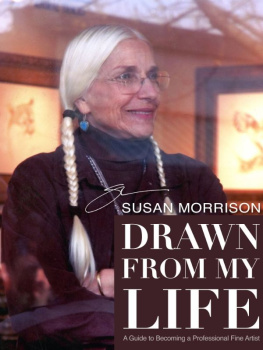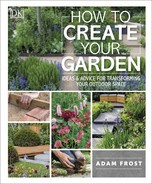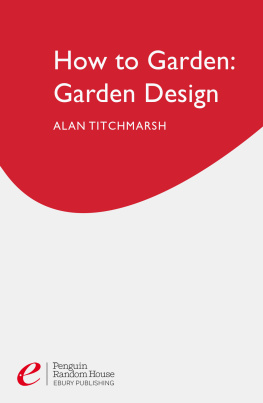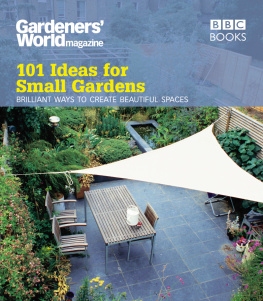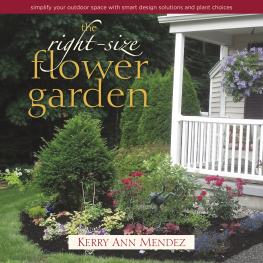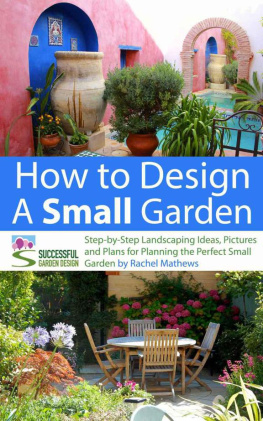
Small spaces can help us appreciate gardenings simple pleasures.
the less is more garden
BIG IDEAS FOR DESIGNING YOUR SMALL YARD
susan morrison
Timber Press
Portland, Oregon
To my mother, Pat Morrison, for being my gardening inspiration, and to my sister Kathy Hawes, who may not know the difference between a daylily and a daphne, but is always my biggest cheerleader.

contents

A small deck surrounded by a small garden makes a perfect spot for relaxing.
foreword
Every time I visit a well-designed small garden it makes me feel envious. These spaces, which are a quarter or less the size of my one-acre property, have more interest, impact, charm, and style than I can imagine for my landscape. As the editor of a national gardening magazine, it is my job to find these spaces that inspire the rest of us to try to improve our own gardens. What the best of these gardens have in common is understanding one simple concept: less is more.
When confronted with something that isnt turning out the way wed hoped, be it a recipe, a living room design, or a garden, our impulse is to add something. That thing we add might just be the key to success. When it is not, we add something else. And things still arent working. What we wind up with is something so full of competing flavors, color, tchotchkes, or plants that we cant even tell what the problem is anymore. Small spaces offer little room for error, so the stakes are higher.
Fortunately, you have this book. Many books on small-space garden design are filled with random, trendy ideas the author merely imagined or happened to have a photo of. This one, however, is written by a real, down-in-the-trenches designer who is as concerned with practicality as she is with beauty. Susan has designed countless small spaces, successful in no small part because she listens intently to the cares and concerns of her clients. This grasp of the hopes, fears, desires, and struggles of people who want the most from their limited space makes her uniquely qualified to help you handle yours.
If you listen to what Susan is saying in this book, and internalize the principles she is proposing, I have little doubt that the garden you create will make me feel envious, too.
Steve Aitken, editor, Fine Gardening magazine
preface
the less is more approach to garden design
Once upon a time, small gardens were mainly confined to the condos, courtyards, and terraces of crowded urban areas. In contrast, the typical suburban landscape tended to be large and sprawling. But in the past forty years, Americas suburban lots have shrunk, from the Southeast to the Midwest to the West Coast. In fact, the term small garden is gradually losing its meaning, as many of us live on a quarter, an eighth, or even less of an acre. Urban and suburban arent so different anymore. Small has become the new normal.
In my practice as a landscape designer, most of the backyards I design measure less than 2500 square feet; layouts are rarely more than 40 by 60 feet. I no longer think of that as small; it has become standard. Interestingly, while active gardeners are often concerned with fitting everything into a space that is generally smaller than the backyards they grew up in, I am just as likely to hear from homeowners more interested in creating a space that will be as simple as possible to maintain. In our time-crunched, overworked, two-career society, taking the time to envision, create, and maintain a garden can seem overwhelming. No one wants another to-do list item, but most of us want a backyard thats a refuge: a place where we can unwind, entertain, and enjoy ourselves in whatever forms those pursuits take.
This shift in how we live, work, and play is what led me to develop the less is more approach to garden design and outdoor living. My clients want to spend more time enjoying the outdoors, but less time fussing with and maintaining their space. I understand what theyre looking for, because the hypothetical family Ive described could be mine.
I spent my middle school and teenage years in a ranch-style home on a quarter-acre lot in Southern California. While the house was a mere 1600 square feet, the large backyard more than made up for the elbow bumping my family of four tolerated inside. We spent as much time as we could outdoors. Our backyard was home to a swimming pool, two full-sized patios, flower beds, fruit trees, and a vegetable garden, not to mention plenty of lawn on which to play games and run around. With that much space, its easy to accommodate an active, multi-generational, outdoor lifestyle. Of course, my childhood memories arent just about fun in the sun. Looking after a space that big took a lot of effort. Growing up as the designated lawn mower and pool cleaner meant my Saturday mornings werent exactly my own.
Fast-forward to my first house in a newly constructed development. Despite the fact that the backyard was a fraction of the size of my childhood homes yard, I did what so many of us do, and modeled the landscape on what I had growing up. While I didnt have the space or the budget for a swimming pool, I replicated the garden I remembered as closely as I could. I made sure there was lots of lawn, and surrounded it with beautiful flower beds. This only left room for one smallish patio, and no dedicated areas to grow a few tomato plants, or to enjoy a good book or a nap. As for practical considerations, such as privacy screening from my all-too-close neighbors, well, I didnt think about that until after Id filled all my planting beds with blooming shrubs and annuals.
While we enjoyed our sunny backyard, my husband and I spent far less time outside than my family had while I was growing up. And because I had created a landscape that included two of the most time-intensive aspects of garden care a lawn and fussy flowers the small space required a lot of effort to maintain. This became a problem for two busy professionals who traveled a lot, as yard upkeep was constantly at the top of our chore list. (More so for my husband than for me. After all those years chained to a weekly mowing schedule, I refused to ever push a lawnmower again.)
We eventually moved to a new home in Northern California, where we finally got it right. Our new backyard was even smaller only 18 feet deep by 60 feet wide. But this time, I embraced the less is more philosophy. At its heart, this approach to garden design means:
Less space, more enjoyment
Less effort, more beauty
Less maintenance, more relaxation
Less gardening-by-the-numbers, more YOU
The pleasure I took in creating the garden of my dreams is what inspired me to trade in my business suits and briefcase for jeans and a drafting table. As a garden designer, I discovered many of my clients were making the same mistakes I had with my first garden. Despite living in California, my typical clients are not movie stars or dot-com millionaires. They are ordinary people just like me, looking to get the most out of modest-sized lots, while juggling jobs, kids, and busy lives.
If this describes you, and you are hoping to get more out of your garden with less time and effort, this book will help you. Twelve years of designing gardens and consulting with homeowners has taught me that the same issues come up over and over again, regardless of budget or lifestyle goals. Whether you are designing a new landscape from the ground up, rehabilitating an existing one, or just hoping to take your current yard to a new level with a few easy fixes, the less is more approach to garden design will get you there.
Next page

